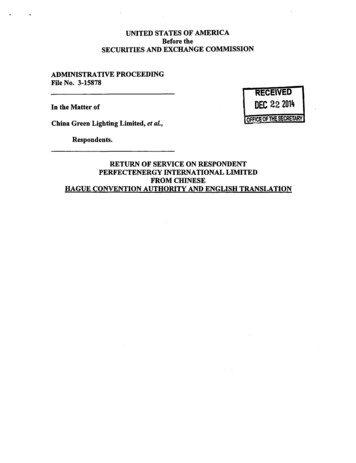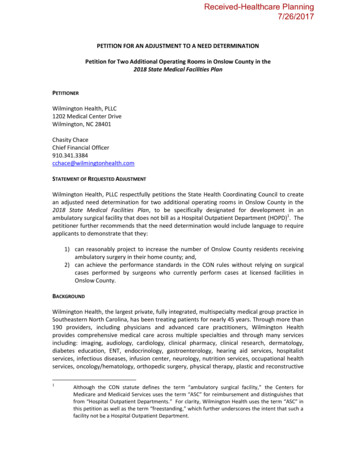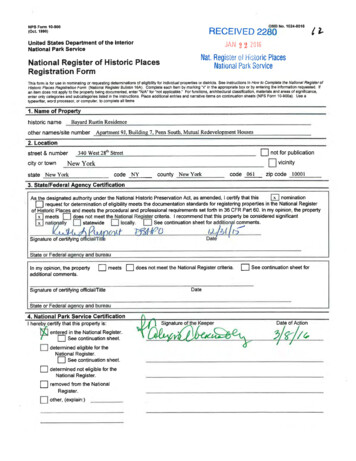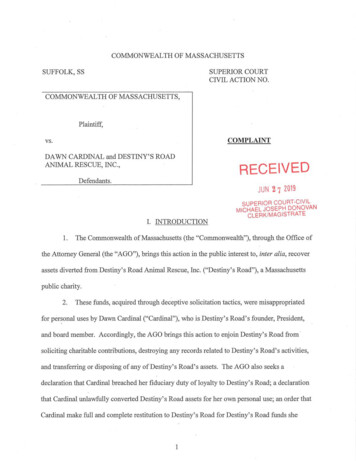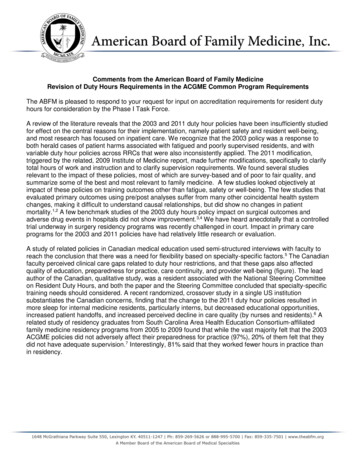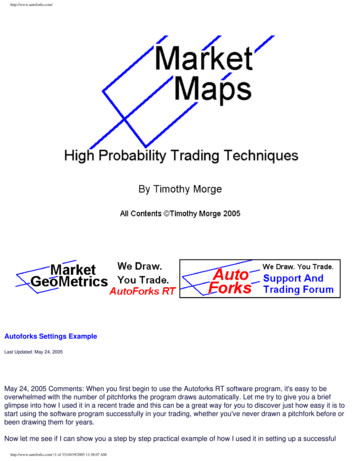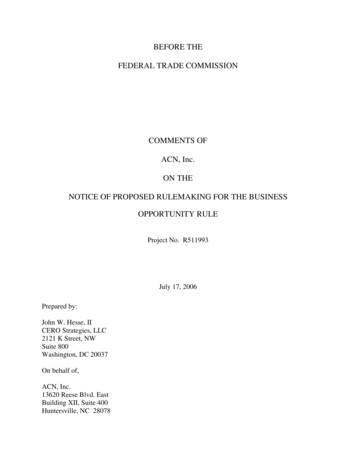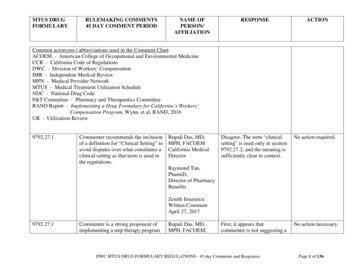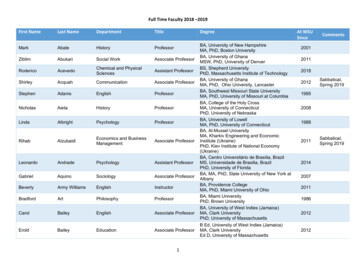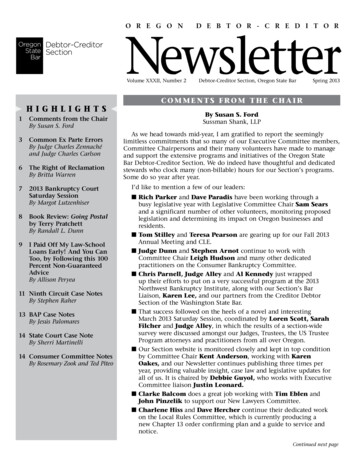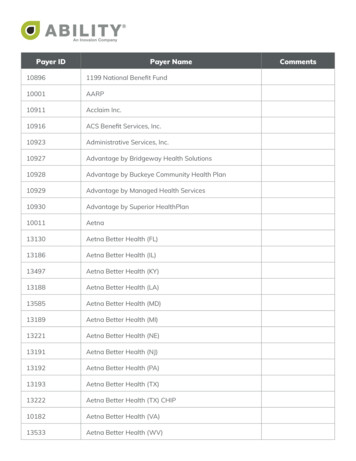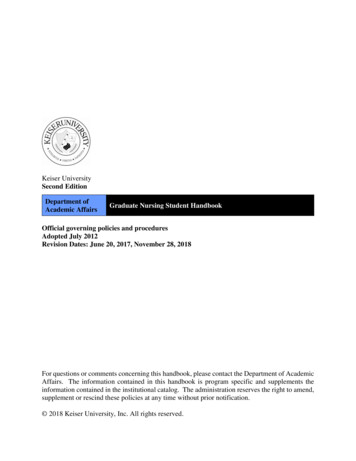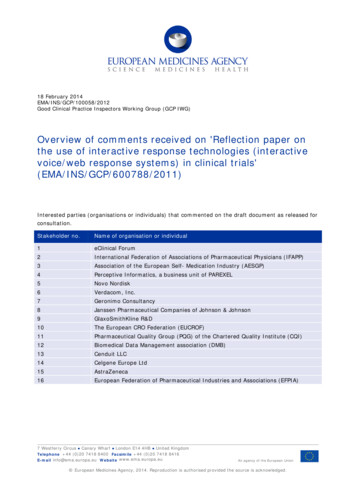
Transcription
18 February 2014EMA/INS/GCP/100058/2012Good Clinical Practice Inspectors Working Group (GCP IWG)Overview of comments received on 'Reflection paper onthe use of interactive response technologies (interactivevoice/web response systems) in clinical trials'(EMA/INS/GCP/600788/2011)Interested parties (organisations or individuals) that commented on the draft document as released forconsultation.Stakeholder no.Name of organisation or individual1eClinical Forum2International Federation of Associations of Pharmaceutical Physicians (IFAPP)3Association of the European Self- Medication Industry (AESGP)4Perceptive Informatics, a business unit of PAREXEL5Novo Nordisk6Verdacom, Inc.7Geronimo Consultancy8Janssen Pharmaceutical Companies of Johnson & Johnson9GlaxoSmithKline R&D10The European CRO Federation (EUCROF)11Pharmaceutical Quality Group (PQG) of the Chartered Quality Institute (CQI)12Biomedical Data Management association (DMB)13Cenduit LLC14Celgene Europe Ltd15AstraZeneca16European Federation of Pharmaceutical Industries and Associations (EFPIA)7 Westferry Circus Canary Wharf London E14 4HB United KingdomTelephone 44 (0)20 7418 8400 Facsimile 44 (0)20 7418 8416E-mail info@ema.europa.eu Website www.ema.europa.euAn agency of the European Union European Medicines Agency, 2014. Reproduction is authorised provided the source is acknowledged.
1. General comments – overviewStakeholder no.General comment (if any)Outcome (if applicable)1) Will the EMA be working with ICH partners to develop a guidelineThere is no proposal at the level of ICH at this time.(See cover page)1that will more uniformly address the use of these computerizedsystems?2)We support the modification of Annex 13 to permit the absence ofNoted. Annex 13 is not being modified at this time.all expiry dating on IMPs, and rely on a risk-based approach to usingthese systems. This will bring the EMA’s requirements more in linewith other global requirements.3) Other regulatory authorities (e.g. US FDA and Japan PMDA) doThe paper presents the current consensus.not require expiry dating on IMPs that are dispensed for subject selfadministration. We ask that the EMA consider expanding thisproposal for the omission of expiry dates to products dispensed toand self-administered by subjects. Since unused IMP must bereturned to the clinical site at each visit, this self-policing will helpensure that only IMP that are of acceptable quality/stability andwithin their expiration date requirements will be available to subjects.4) There are other systems in use today that are not specificallyThe scope of the paper is to provide guidance on whatidentified as IV/IWRS applications but these systems keep track ofNational Competent Authorities expect from IRT systemsrandomisation/product shipment/expiry information. It would beand in particular their use for handling of the expiry date ofhelpful to more generically categorize these applications so that thethe Investigational Medicinal Product. It is not intended toprinciples required by this paper might apply to all computer systemsaddress all tracking systems.that perform these functions.5) Does the EMA have specific recommendations as to theNoOverview of comments received on 'Reflection paper on the use of interactive response technologies (interactive voice/web responsesystems) in clinical trials' ge 2/91
Stakeholder no.General comment (if any)Outcome (if applicable)(See cover page)information about these computerized systems that should beincluded in study protocols, or market applications?6) This reflection paper stresses the importance of drugThe importance of drug accountability is inherent in theaccountability when using IV/IWRS systems. Might it be useful tolegislation and is covered by GCP.include a statement in the introduction that makes the point thatThe guide cannot be so prescriptive with all the differentdrug accountability is an important component of drug managementsystems in use.(see line 54) for automated systems to track? Also, will this paperinclude guidance on how information should be tracked in theIV/IWRS and/or the EDC system at the clinical site? For example,will this paper suggest that these systems need to be interoperable,and that any systems validation efforts needs to challengealgorithms/procedures that account for the IMP?2Well prepared guideline, addressing an important issue.All trials have a sponsor as per EU legislation.IFAPP agrees with its contents and has no special comment tosubmit.The document provides a detailed and useful analysis on the overallaspects of quality in clinical trials.In IFAPP opinion however too much emphasis is given to sponsoredclinical trials only, while more attention should be paid toInvestigators’ activated trials.Recent data suggest that up to 35% of clinical trails belong to thecategory of “Investigators’ activated trials” and experience suggestthat many of these trails are still – after almost 20 years of GCPimplementation - of low and unacceptable quality, exposing patientsto unnecessary risks.IFAPP recommends that some parts of this guideline are devoted tothis category of trials, with clear recommendations to EthicsOverview of comments received on 'Reflection paper on the use of interactive response technologies (interactive voice/web responsesystems) in clinical trials' ge 3/91
Stakeholder no.General comment (if any)Outcome (if applicable)(See cover page)Committees to supervise the overall organisation of these studies,and to approve them only when a clear indication of managementstructure and monitoring plan is provided.4This is a conservative document which does not follow the thrust ofThe paper presents the current consensus.the ISPE document that is referenced within the guidance. The ISPEdocument essentially advocated the expansion of the use oftechnology in removing use-by-date dates from labels. The ISPEdocument mentioned some of the problems that can occur withrelabelling and some of these could apply when a pharmacist addsthe use-by-date on the label. We would consider a risk basedapproach to each particular trial to be more appropriate. This riskbased approach is being applied in other guidances e.g. EMAreflection paper on risk based quality management in clinical trials.The risk based approach for use-by date labels would depend on theparticular medication/treatment and the chances of the subject notreturning the medication. We note that it is an expectation that thesubject returns all the trial materials.4The document mentions the situation in U.S and Japan that currentlyThe paper presents the current consensus.applies to use-by date labelling. Whilst it is clearly not appropriate tocriticise other regulatory authorities, it would be good to seediscussion of why the same approach is not being taken in the E.U. Acommon approach would seem to be more consistent with thephilosophy of I.C.H. and the philosophy of harmonising proceduresfor sponsors so they can devote more resources to the developmentof new treatments.4The title does not reflect the content of the paper which isThe paper has been restructured taking this into account.concentrated primarily on the use of such systems to handle use-byOverview of comments received on 'Reflection paper on the use of interactive response technologies (interactive voice/web responsesystems) in clinical trials' ge 4/91
Stakeholder no.General comment (if any)Outcome (if applicable)(See cover page)date labels. The title might lead the reader to expect many moretopics to be addressed including, but not limited to, matters arisingfrom the usual separation of the randomisation and dispensing stepswhere any pack of the appropriate treatment can be dispensed to anypatient e.g. pooling of medication across studies, scrambling of kitlists to maintain the blind, what to do in case of supply failures etc.5Please be consistent in using IVRS/IWRS in the document or evenAccepted IRT will be used throughout.better to change to “IRT system” which is used in the title of thisreflection paper6From my understanding this document began as a way to justifyThe paper has been restructured to give more emphasis toremoving the expiry dates from labels in the EU as put forward byIRT.ISPE. The document as titled here seems to have much larger scope.My concern is this - do other regulated technical systems used in EUclinical trials subject to detailed regulation and have similardocuments listing vendor, sponsor, quality, sdlc requirements?Wouldn't it be sufficient for this doc to reference GCMP, GAMP, SOXand other relevant guidelines?We reviewed this draft several months ago and felt we were incompliance, but the idea that the sponsor/vendor relationship arebeing 'reflected on' seems troubling.Vendors know what the requirements are; any sponsor QA groupwould know the risks involved with using systems for inventorymanagement and randomisation and take appropriate safeguards.I would like to see this document limited to guidance about expirydate labelling or generalised to recommendations on managing allsoftware development vendors involved in managing submissionrelated data: electronic data collection, patient recruitment, inventorysupply chain, patient reported outcome systems, etc.Overview of comments received on 'Reflection paper on the use of interactive response technologies (interactive voice/web responsesystems) in clinical trials' ge 5/91
Stakeholder no.General comment (if any)Outcome (if applicable)The reflection paper title is Interactive Response Technologies, this isIRT to be used.(See cover page)7generally abbreviated as IRT; the abbreviation used in the paper isIVRS. This is an old abbreviation, not in line with the currentstandard (IRT) and the terminology used by the ISPE.8Overall, we found section 2.2 of the document to be confusing,The paper has been restructured for clarification.particularly section 2.2.2 regarding P2 – P4 studies.It would be easier for the reader if the recommendations outlined inthe document were structured under clear sections, e.g. Guidance tosponsor, Guidance to IVR/IWR Providers.9This recognition by EMA of the importance of IVRS/IWRS technology-to the conduct of clinical trials is welcome. In particular, it isappreciated that there is acceptance of the fact that such systemsmight, in certain circumstances, be used to justify the removal ofexpiry dates from Investigational Medicinal Product (IMP) labels andthus overcome challenges with expiry date extensions in the field.9It is disappointing that the paper’s perspective is that “There isThe paper presents the current consensus.currently no justification for omission of labelling of use-by date ifthe IMP is handed out to trial subjects for use at home” (lines 119121). This is much more restrictive than in other countries, such asthe US, and significantly limits the potential benefits that may bederived from such systems. The only reason given for this position is“Patients not returning kits and then utilising them past their expirydate” (line 125). Given the requirements for IMP accountability, itshould be possible to address this scenario and it should notfundamentally be a reason for needing use-by dates on labels. Wesuggest that if a company was able to demonstrate a robust systemfor ensuring materials did not remain with trial subjects past theirexpiry date, then there could be a justification for omitting the useOverview of comments received on 'Reflection paper on the use of interactive response technologies (interactive voice/web responsesystems) in clinical trials' ge 6/91
Stakeholder no.General comment (if any)Outcome (if applicable)(See cover page)by date from the labels of IMPs taken home by subjects.9Given the perspective requiring use-by date labelling of IMPs that areThe paper presents the current consensus.to be taken home, it would be beneficial if EU regulations could beupdated to facilitate the addition of this information at the point ofdispensing. Currently, the labelling of IMPs is governed by Directive2001/20/EC in the majority of cases and requires ManufacturingAuthorisation and QP certification, preventing this being undertakenby a pharmacist at an investigator site. The exceptions of Directive2005/28/EC, Article 9, Paragraph 2, are limited to reconstitution and‘non commercial’ institution-led trials.9The document reads as though it was originally intended to addressThe paper has been restructured.the specific circumstances where the removal of expiry dates couldbe justified (2.2 with 2.1 providing a legal preamble to this) and thata number of more general aspects, such as specification, standards,validation, etc. were added on subsequently (2.3). It would bebeneficial to restructure the document to address generalrequirements first.9The document is mainly written with the assumption that theThe paper has been restructured. This has been madeIVRS/IWRS service is provided by a party other than the Sponsor.clearer.This is not always the case; IRSs may be managed by the Sponsordirectly as an in-house activity. The document would benefit fromrevision to better reflect this possibility.9The document also considers IR systems as ‘stand alone’ and doesThe paper has been restructured.not address the fact that they may be integrated with other systems,from which data regarding expiry dates may be sourced. Greaterintegration of IR technology within broader clinical supply chain anddata management systems is likely to be seen in future. Thisdocument should be written to recognise such trends and to ensureOverview of comments received on 'Reflection paper on the use of interactive response technologies (interactive voice/web responsesystems) in clinical trials' ge 7/91
Stakeholder no.General comment (if any)Outcome (if applicable)(See cover page)that future advances are not restrained in any way.9There are specific challenges associated with expiry date extensionsNot clear what suggestion is.through systems interfaces, especially where there are differentranges of containers. The document does not clearly cover suchscenarios currently.9The document mentions the delivery of documents or printouts withThis has been considered in the revised version of theuse-by date information in a number of places. Where blindedpaper.clinical supplies are concerned, it is important that information inthese does not result in unblinding, e.g. as a consequence of differenttreatment arms having different technical shelf-lives. It is suggestedthat this is stated explicitly within the document.9Also relating to documents and printouts, the possibility of clinic staffhaving on-line access to data within a controlled system should beThis has been considered in the revised version of thepaper.allowed for, rather than specifically requiring paper documents.9Section 2.3.1.1 should clearly specify the accountability of theSponsor for URS, UAT and formal acceptance of the system for use.9Further detail within Section 2.3.3 would be useful to clarify what theregulatory expectations are for items such as emergency unblinding,This has been considered in the revised version of thepaper.This has been considered in the revised version of thepaper.disaster recovery, currency of data, etc.9In addition to the specifics relating to updates to the system inSection 2.3.5, it should be clear that the sponsor needs to be able toThis has been considered in the revised version of thepaper.demonstrate a full chain of control regarding expiry date informationwhich goes beyond the IRT itself, i.e., there needs to be control overthe feed-ins to the system.9The Annex I QP declaration appears to be added bureaucracy withunclear value. It is agreed that the certifying QP should ensure thatThis has been considered in the revised version of thepaper.if an IVRS/IWRS is used to control expiry dates then it is fit forpurpose and there is traceability back to appropriate audits.Overview of comments received on 'Reflection paper on the use of interactive response technologies (interactive voice/web responsesystems) in clinical trials' ge 8/91
Stakeholder no.General comment (if any)Outcome (if applicable)(See cover page)However, the audit/validation traceability could be addressed throughan internal control and the needs of those downstream covered bythe QP’s certification of the batch. To create and maintain a form inevery Product Specification File and Trial Master File (ref. line 135) isunnecessary bureaucracy.Furthermore, what is the objective of listing assembly anddistribution sites and including them within this? Should thedeclaration be retained, then the focus should be on the IRS itself,not specific locations within the supply chain.9Should the requirement for the Annex 1 QP declaration be retained,guidance notes on its completion will be required. For example, whatThis has been considered in the revised version of thepaper.is meant by the ‘date of last audit (completion)’? Is this the last dayof fieldwork; date of report issue; date of Corrective Action Planacceptance; date of closure of all actions arising from the audit?In addition to having confidence in the IVRS/IWRS itself, the QPshould have confidence that appropriate control processesThis has been considered in the revised version of thepaper.(procedures) are in place regarding its configuration, use andmaintenance.10EUCROF is very much in favour of the document you provided,especially regarding the attempt to clarify expiry date administrationThis has been considered in the revised version of thepaper.and providing requirements when using IxRS vendors. However, wedo feel that the text is not written in a uniform style and uniformlevel of clarity. Some parts of the document provide full text blocks,others are limited to bullet points only. Some abbreviations are notexplained, references are missing and some sentences are notcorrect. Although we understand that this is a draft text only anddoes not have to be 100% perfect, we do think that appropriatequality control should be applied before posting a document into theOverview of comments received on 'Reflection paper on the use of interactive response technologies (interactive voice/web responsesystems) in clinical trials' ge 9/91
Stakeholder no.General comment (if any)Outcome (if applicable)(See cover page)public domain in order to ease the review process.10Section 26 of Annex 13 states “The following information should beincluded on labels, unless its absence can be justified, e.g. use of aThis has been considered in the revised version of thepaper.centralised electronic randomisation system:”It would be very welcome to learn about clear expectations as towhich of the items a – k of section 26 of Annex 13 can be omitted onthe label if they are fully represented and administered by the use ofa centralised electronic interactive voice/web system.11This recognition by EMA of the importance of IVRS/IWRS technologyto the conduct of clinical trials is welcome. In particular, it isThis has been considered in the revised version of thepaper.appreciated that there is acceptance of the fact that such systemsmight, in certain circumstances, be used to justify the removal ofexpiry dates from Investigational Medicinal Product (IMP) labels andthus overcome challenges with expiry date extensions in the field.IVR and IWR technology is likely to become more integrated intoclinical supply chain and data management systems in future andthere is concern that this document is written in a manner that mayconstrain technological advances. This document should
9 This recognition by EMA of the importance of IVRS/IWRS technology to the conduct of clinical trials is welcome. In particular, it is appreciated that there is acceptance of the fact that such systems might, in certain circumstances, be used to justify the removal of expiry date
